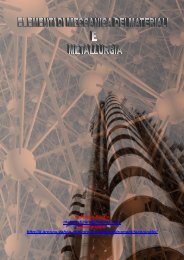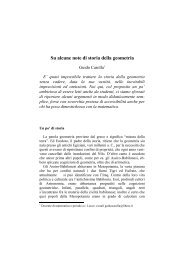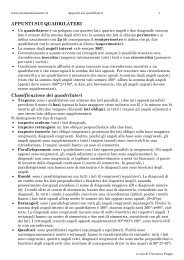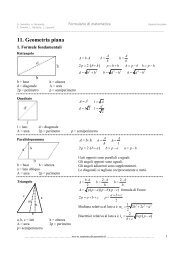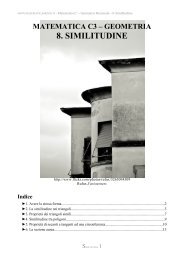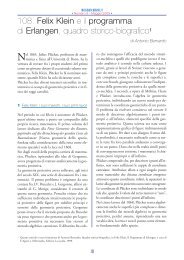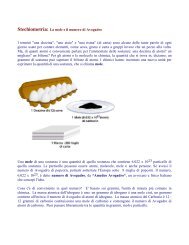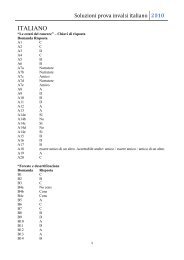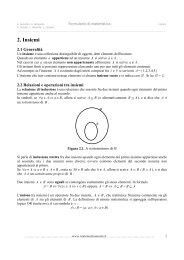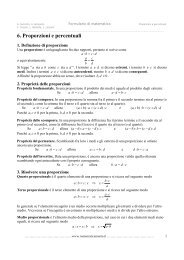Scarica la tesi Integrale di Feynman sui Cammini e Processi Stocastici
Scarica la tesi Integrale di Feynman sui Cammini e Processi Stocastici
Scarica la tesi Integrale di Feynman sui Cammini e Processi Stocastici
You also want an ePaper? Increase the reach of your titles
YUMPU automatically turns print PDFs into web optimized ePapers that Google loves.
Il terzo postu<strong>la</strong>to è motivato dal fatto che le ampiezze quantistiche sod<strong>di</strong>sfano<br />
il Principio <strong>di</strong> Sovrapposizione. Tale principio implica che l’ampiezza totale<br />
〈x ′′ , t ′′ |x ′ , t ′ 〉 per l’evento A debba essere <strong>la</strong> somma delle ampiezze 〈x ′′ , t ′′ |x ′ , t ′ 〉[x(·)]<br />
re<strong>la</strong>tive ad ogni singo<strong>la</strong> alternativa <strong>di</strong>sgiunta. Quin<strong>di</strong>:<br />
Postu<strong>la</strong>to 3 Il Propagatore Quantistico è dato da<br />
<br />
〈x ′′ , t ′′ |x ′ , t ′ 〉 =<br />
Questa ultima espressione è l’eq.(13).<br />
Dx(t)〈x<br />
C<br />
′′ , t ′′ |x ′ , t ′ 〉[x(·)].<br />
0.4 Natura e Caratteristiche dei <strong>Cammini</strong> <strong>di</strong> <strong>Feynman</strong>.<br />
I <strong>Cammini</strong> <strong>di</strong> <strong>Feynman</strong> hanno significato fisico?<br />
Consideriamo una regione R dello spazio dei cammini C(x ′ , t ′ ; x ′′ , t ′′ ), R ⊂ C.<br />
Partendo dai postu<strong>la</strong>ti, vogliamo mostrare che non esiste alcuna <strong>di</strong>stribuzione<br />
c<strong>la</strong>ssica <strong>di</strong> probabilità definita sullo spazio dei cammini C. Consideriamo un<br />
generico cammino x(t) ∈ C. La probabilità che <strong>la</strong> particel<strong>la</strong> S si muova lungo<br />
tale cammino x(t) è<br />
P (x ′ , t ′ ; x ′′ , t ′′ )[x(t)] = |〈x ′′ , t ′′ |, x ′ , t ′ 〉[x(t)]| 2<br />
(14)<br />
Ora secondo il calcolo c<strong>la</strong>ssico delle probabilità si dovrebbe avere che <strong>la</strong> probabilità<br />
che il generico cammino sia contenuto in R è:<br />
<br />
P rob{x(t) ∈ R} = Dx(t)P (x ′′ , t ′′ ; x ′ , t ′ )[x(·)] (15)<br />
R<br />
Seguendo invece i postu<strong>la</strong>ti <strong>di</strong> <strong>Feynman</strong> il risultato è <strong>di</strong>verso; ve<strong>di</strong>amo in<br />
che senso. Per il Postu<strong>la</strong>to 3 l’ampiezza <strong>di</strong> probabilità <strong>di</strong> trovare il generico<br />
cammino x(t) nel<strong>la</strong> regione R ∈ C è:<br />
<br />
Amp{x(t) ∈ R} = Dx(t)〈x ′′ , t ′′ |x ′ , t ′ 〉[x(·)].<br />
Dunque dall’eq.(14) segue che:<br />
<br />
P rob{x(t) ∈ R} = |<br />
R<br />
Dx(t)〈x<br />
R<br />
′′ , t ′′ |x ′ , t ′ 〉[x(·)] | 2 . (16)<br />
Abbiamo dunque che l’eq.(15) è <strong>di</strong>fferente dall’eq.(16)<br />
<br />
<br />
Dx(t)|〈x<br />
R<br />
′′ , t ′′ |x ′ , t ′ 〉[x(·)]| 2 = |<br />
Dx(t)〈x<br />
R<br />
′′ , t ′′ |x ′ , t ′ 〉[x(·)] | 2 . (17)<br />
Questo risultato sottolinea <strong>la</strong> non vali<strong>di</strong>tà del calcolo delle probabilità c<strong>la</strong>ssico<br />
in MQ. Ciò suggerisce che i cammini <strong>di</strong> <strong>Feynman</strong> non possono essere visti<br />
come possibili traiettorie descritte da una particel<strong>la</strong> in accordo con il senso<br />
comune. Per sottolineare <strong>la</strong> non realtà <strong>di</strong> tali cammini lo stesso <strong>Feynman</strong> suggerisce<br />
<strong>di</strong> pensare che <strong>la</strong> particel<strong>la</strong> percorra simultaneamente tutti i cammini 3 .<br />
E’ noto infatti che in MQ non è possibile attribuire proprietà fisiche ben definite<br />
ad oggetti non osservati!<br />
3 Questa idea è analoga all’esperimento delle due fen<strong>di</strong>ture: l’elettrone passa per entrambe.<br />
5



